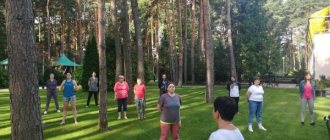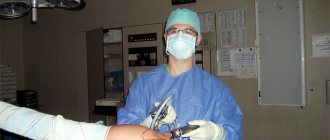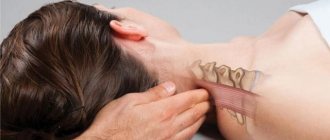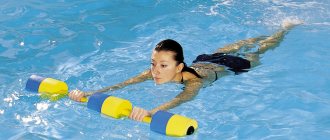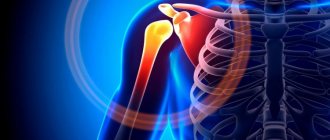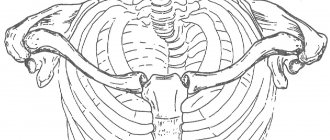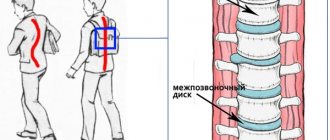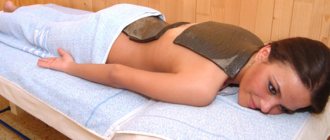Common types of chronic joint pathology include osteochondrosis of the shoulder. The disease most often develops due to a genetic predisposition, a sedentary lifestyle or under the influence of external factors. People suffering from dystrophic disorders know firsthand what pain, crunching, rapid fatigue and limitation of movements in the upper limb are.
Traditional and alternative medicine has different treatment methods in its arsenal: medications, physiotherapy, hirudotherapy, massage, acupuncture. Exercise therapy is also widely used. Exercises for shoulder osteochondrosis help cope with the symptoms of the disease and return a person to the usual rhythm of life.
Causes of shoulder osteochondrosis
More often, shoulder osteochondrosis develops as a result of lesions of the cervical spine. Therefore, doctors usually use the term cervical-brachial syndrome. The impetus for development can be any factors that provoke osteochondrosis:
- sedentary life with low physical activity;
- genetic predisposition;
- constant work at the computer, prolonged stay in a static position;
- poor posture;
- malnutrition, deficiency of vitamins and microelements;
- injuries (dislocations, fractures, sprains) of the anatomical structures of the shoulder;
- unevenly distributed physical activity (mainly on one shoulder).
- infectious diseases (osteochondrosis of the shoulder can be complicated by sexually transmitted infections, streptococcal infections or tuberculosis);
- overweight, obesity;
- arthrosis (in older people).
As a result of the changes occurring, muscles and nerves in the cervical region are pinched, which provokes circulatory disorders. The structure of the joint tissue of the shoulder is the first to be affected. A lack of chondroitin, vitamins, glucosamine and nutrients causes a disorder in the glenohumeral region, which entails atrophy and the transition of the pathology to a chronic course.
The effectiveness of physical exercise in the fight against osteochondrosis
In the acute stage of osteochondrosis, the use of therapeutic exercises is contraindicated. To reduce pain, the patient is recommended to stretch the spine. Increasing the intervertebral distance leads to muscle relaxation and reduced irritation of the nerve roots. It is also necessary to avoid a soft mattress.
The positive result from physical therapy is most noticeable in the initial stages of the formation of osteochondrosis. Classes activate the internal processes of the body: blood circulation accelerates, muscle tone and the functioning of the spinal motion segment are normalized.
Regular use of therapeutic exercises for the shoulder girdle helps:
- increase metabolism in damaged tissues;
- increase the flow of lymph and blood;
- strengthen muscles and ligaments;
- improve posture;
- restore musculoskeletal activity.
At the beginning of the development of osteochondrosis, exercise therapy is aimed at reducing irritation of the nerve roots in contact with the affected intervertebral discs.
Despite the positive effect of using gymnastics, you should only perform exercises that do not exacerbate the pain syndrome. Classes should be started only after consulting a doctor, under the supervision of a specialist. Movements should be smooth, slow, and the body should be completely relaxed.
Only loads acceptable to the body help you recover; you shouldn’t overwork yourself during training.
Physical exercises using a crossbar
The crossbar is a projectile that will be used to gradually stretch muscles, relieve fatigue and pain.
It is important to use the projectile only in the initial stages of the disease. If there is severe deformation of the shoulder girdle or spinal column, the proposed complex can cause harm. That is why you should contact a doctor and consult with him before performing it.
If the doctor's permission has been received, you can begin gymnastics using the crossbar.:
- Holding the bar, you should lean on it to swing to the sides, forward and backward.
- Gently tilting your head back, you should gradually bend your back. Do it 10 times.
- Rotate your body, holding onto the apparatus, bring your legs together. Perform in three approaches, 5–7 times each.
- Pull your legs towards your stomach, bend them at the knees, sagging on the bar. Stay in this position for at least 5–7 seconds.
- “Draw” small circles with your feet, leaning on the projectile all the time. 5-7 times with each leg.
- Move your legs to the right and left, performing peculiar lunges. 10 times is enough.
- Pull yourself up above your chin 3-5 times.
- Pull your body to the level of your stomach and gently bend your back. Stay in this position.
- In a hanging position, slowly raise your straight leg towards your stomach and stay in this position for 10 seconds.
- Gently mix your body on the bar - you can take 3-5 “steps” on each arm.
Women should spread their arms shoulder-width apart, men should spread them a little wider to increase the load.
Indications for performing therapeutic exercises
Treatment of exercise therapy for osteochondrosis is prescribed:
- with concomitant kyphosis, scoliosis, other pathologies of the spine and adjacent tissues;
- after stopping the acute stage of the disease;
- in the presence of cardiovascular and respiratory disorders;
- if there is a possibility of vertebral fusion;
- with a weak muscle corset.
Symptoms of the disease, which are an indication for joint gymnastics, can vary significantly, depending on the causes and stage of development. The most typical manifestations include:
- pain during exercise, movement, staying in one position for a long time, sometimes even when inhaling, coughing, sneezing;
- excessive fatigue of the shoulder girdle, even with minor physical exertion;
- stiffness and limited mobility in the shoulder area, when abducting or raising the arm;
- pain may spread to the neck or arms;
- crackling, crunching, itching in the joint.
In the chronic stage, osteochondrosis of the shoulder can manifest itself as dizziness, headache, hearing, vision and coordination impairment.
How often to exercise
The training prescribed by a specialist for treatment must be carried out daily. In addition, people with osteochondrosis, whose activities are associated with sedentary work, should do a warm-up directly during work (whenever possible, ideally for a few minutes every hour).
It is important to strengthen your muscles regularly. Even light warm-up movements, when carried out regularly, will help avoid relapses of exacerbation of the disease and reduce the intensity of pain. There is no need to quit therapeutic exercises if your condition worsens after them. You should contact a specialist, he will prescribe a new set of exercises.
With the right gymnastics, the positive effect is felt immediately after class. The choice of a set of exercises should be made by a doctor based on the degree of damage to the structures. Sometimes various exercise machines and devices can be used for training, for example, a stick, an expander.
In terms of duration, at first all movements are repeated about 5 times, gradually increasing the number of approaches up to 12 times.
A set of exercises for shoulder osteochondrosis
The shoulder joint is responsible for normal mobility of the upper limb. Exercises aimed at developing the muscles of the shoulder girdle are used as a prevention and treatment of osteochondrosis. When doing gymnastics at home, you need to distribute the load evenly, monitor the correct placement of your legs, body position (do not lean forward), and posture. At first, perform the movements slowly, then speed up the pace. The approximate duration of exercise therapy is 15-20 minutes.
Exercises for shoulder osteochondrosis
- Hands on your waist, feet shoulder-width apart, make several circular turns with your shoulders forward, then in the opposite direction.
- Place your hands behind your back in a lock so that the affected limb is on top. Using your healthy hand, slowly pull the painful one down.
- Place the hand on the side of the osteochondrosis on the adjacent shoulder, for example, the right on the left. Place the second healthy limb on the “neighbor’s” elbow and gently pull the injured arm up.
What exercises will help with cervical osteochondrosis?
The disease manifests itself in different segments of the spine, but most often degenerative-dystrophic changes are observed in the cartilaginous and bone structures of the cervical spine. The main reason is constantly being in an uncomfortable, tense position.
Exercises for cervical osteochondrosis are simple and can be repeated by anyone both at home, at work, and away:
- Standing, lower your head down and try to touch your chin to your chest.
- Sit on a chair, straighten your back, stretch your neck. Then turn your head left and right alternately.
- Sit down, tilt your head forward as you inhale, straighten it and tilt it back as you exhale.
- Starting position: lying on your stomach face down. At the same time, relax completely. The arms are positioned along the body, palms up. Slowly turn your head to the right, straight, then left.
- Sit at the table, lean your elbow on it. Place your palm on your temple, creating resistance with your hand, tilt your head to the side.
Recommended training complex
If the shoulder girdle is affected, doctors recommend paying attention to the back during physical therapy , for which the following exercises are recommended:
- Pull arms in the chest and behind the head with tension in all muscles.
- Bend forward, left and right with a stick held above your head.
- Lunges forward and to the sides with small dumbbells. This exercise can be done by those who have been involved in physical education for some time. To begin with, you should not use additional loads.
- Hyperextensions are exercises that involve straightening the back during exercise.
It is important to perform the recommended set of exercises for osteochondrosis of the cervico-brachial region every day. This will strengthen your muscles and eliminate stiffness and pain.
The complex may include more complex workouts, which are indicated for patients who suffer from osteochondrosis of the shoulder area.
№1
Place your hand behind your head in the shoulder area, and the other below. Try to reach with one hand to the other and clasp your palms. Remain in this position for at least 10–30 seconds. Clasp your palms with the outer side facing out. You cannot move your elbows and shoulders while performing the complex. During the process of performing the complex, a person will feel pleasant warmth and stretching in the sore area.
№2
To perform this, you should use a wide belt or a rolled towel. You should pass the “projectile” through your hands behind your back and fix it in this position. Hands should remain shoulder-width apart while performing the exercise. Gradually, without sudden efforts and movements, you should move your elbows apart, overcoming the tightness of the tourniquet.
№3
While sitting or standing, extend both arms forward and cross your fingers. Gradually raise your arms up above your head, without unclenching your arms. The complex allows you to stretch muscles and relieve tension without injury.
Performing the basic set of exercises daily allows you to relax your muscles, relieve tension, fatigue, and get rid of pain.
Author's methods of physical therapy for illness
Often, patients are recommended to use original training methods. The most popular are:
Bubnovsky's gymnastics
The class is conducted on simulators developed by the doctor. There are some exercises you can do at home:
- Lean your back against the wall, remember the position and take one step. Bring your shoulder blades together without raising your shoulders, hold, then carefully, through the starting position, bring your shoulders together in front.
- Through the same starting position, raise your shoulders up, trying to reach your earlobes.
- Next, place your fingers on your shoulders and perform rotational movements.
- Get on all fours and bend your chest as much as possible.
Gymnastics by A. Bonina
Alexandra is a sports doctor and fitness instructor; she collected the exercises, testing them first of all on herself.
- Starting position – sitting on a chair, without leaning on the back:
- Place your hands on your knees in a relaxed state, squeezing and spreading your shoulder blades.
- Lower your straight arm and raise it in a straightened state. Alternate limbs.
- Raise your hands in front of you and join your palms, as if in prayer, clench your palms, tensing the muscles of your shoulders, arms and chest.
A. Bonina’s technique is effective for pain syndrome and is suitable for both remission and periods of exacerbation of osteochondrosis. It is recommended to conduct the exercise in front of a mirror to control the body.
Exercises for osteochondrosis of the cervical spine. Basic recommendations
Classes should begin after the exacerbation phase and not stop when the condition first improves. A few more basic recommendations:
- Before performing exercises, it is necessary to ventilate the room;
- classes should be carried out no earlier than half an hour after meals;
- muscles are warmed up before exercise therapy;
- you can rub your body with a towel (optional);
- you need to start with simple exercises and gradually move on to more complex ones;
- you need to breathe through your nose;
- monitor your pulse.
After just a month of proper exercise, you will feel an improvement in your body’s condition.
Rest during exacerbation
In case of exacerbation of osteochondrosis, in case of acute pain, it is necessary to observe bed rest. Under no circumstances should you perform exercises that cause pain or cancel them completely.
Relief from pain during remission
This is a set of exercises that does not require much physical effort. As a result of their implementation, the patient’s muscle tone is gradually improved. These exercises are performed with and without the use of machines.
Maintain a balance between strength and resistance.
Treatment of osteochondrosis with special exercises should be carried out using light loads. In this case, the patient quickly gets rid of tiresome pain. For each type of osteochondrosis, its own therapeutic exercises have been developed.
At the initial stage, for cervical osteochondrosis, small amplitude exercises are used, using resistance to neck movements with the hand. The patient overcomes resistance, thereby strengthening the neck muscles. The next stage is active exercises and circular rotations of the head, but at a slow pace. As a result of their implementation, the mobility of the cervical joints improves.
When treating thoracic osteochondrosis, all exercises are performed standing. These are arm swings and body bends. But the warm-up is done while sitting on a chair. It consists of bending your back back (arms behind your head) while inhaling. As you exhale, lower your arms along your body. All exercises must be performed slowly without sudden movements.
Correct body position
Our body position during sleep and rest, even if it seems comfortable to us, does not always contribute to improving the condition of the body. It is necessary to take the correct postures.
In what cases are exercises contraindicated?
Performing exercises for osteochondrosis helps improve well-being and stop degenerative changes. But there is a certain list of contraindications for exercise therapy:
- acute period of the disease;
- severe myopia, high intraocular pressure;
- postoperative, beginning of the rehabilitation period;
- disorders of the vestibular apparatus;
- hypertension, arrhythmia, tachycardia;
- neurological pathologies combined with incoordination of movement;
- threat of bleeding;
- severe forms or periods of exacerbation of any disease (malignant neoplasms, myocardial infarction, diabetes mellitus, infectious pathologies).
Exercises for osteochondrosis are not recommended to be done immediately after meals, on an empty stomach or after physical fatigue.
Warm-up workout
Any set of exercises should begin with a warm-up. It allows you to warm up the muscles and prevent injury.
A special exercise is proposed to relieve tension and warm up the muscles. To perform it, you should kneel down and place soft mats or pillows in front of you. You should lean forward and lie on the pillows, allowing your body to relax as much as possible. Remain in this position for 30–60 seconds. It is possible that a person will feel a pulling sensation in the shoulder area.
There is no need to overdo it and press yourself into the pillows; there is also no need to lower your body too low to create tension. A comfortable position that will not make breathing difficult is what the patient needs. You should not start exercising on an empty stomach, and if sharp pain appears, you should wait a little until it subsides.
Precautionary measures
At first, exercise therapy consists of simple exercises that do not require additional physical skills. The selected activities must strictly correspond to their purpose. If during the implementation of the treatment complex the patient notices increased pain or lack of benefit, then it is necessary to consult a doctor.
During the first three workouts, mild pain is possible. Afterwards, the body adapts to unusual loads, which makes it easier to perform physical techniques. In the future, you should not ignore pain during exercise, as it is the main warning sign.
Before starting exercise therapy, it is necessary to prepare the body well and warm up the area of the thoracic spine, the clavicular-scapular area. 5-15-minute water procedures with 37°C water are excellent for this. You can also apply a dampened towel or heating pad to the desired area of the body. Sometimes a folk remedy is used to warm up the muscles - compresses with dimexide.
Do not overdo it from the first minutes of training. The exercises should be carried out smoothly and unhurriedly, excluding jerks and sudden movements. Dynamics and amplitude should increase gradually. Regular monitoring of equipment will reduce the likelihood of exacerbation of an existing condition or injury.
An active lifestyle as the main measure for the prevention of osteochondrosis
Prevention of osteochondrosis is primarily movement. Sports, walking, therapeutic exercises, and simple exercises help relieve stress on the intervertebral discs and strengthen the back muscles. The main reason for the development of the disease is that in ordinary life people move incorrectly, which creates unbearable loads on the spine. Prolonged sitting, standing, carrying bags on one shoulder and lifting heavy loads put stress on the back, mainly the cervical region.
You should know moderation in everything: excessive physical activity is just as harmful as its absence. Improper muscle contraction, for example, when playing tennis, volleyball, basketball, on the contrary, creates conditions for the development of osteochondrosis.

